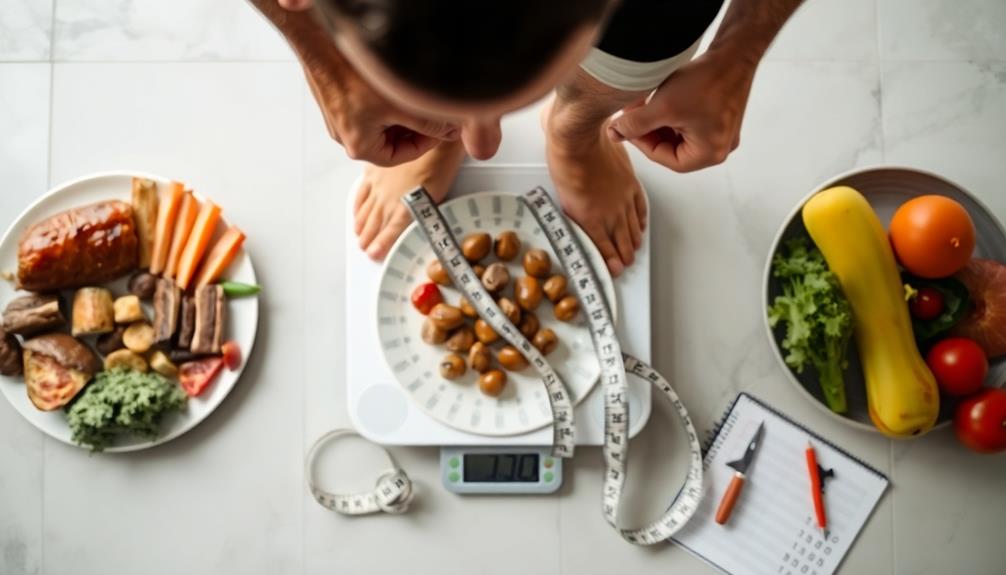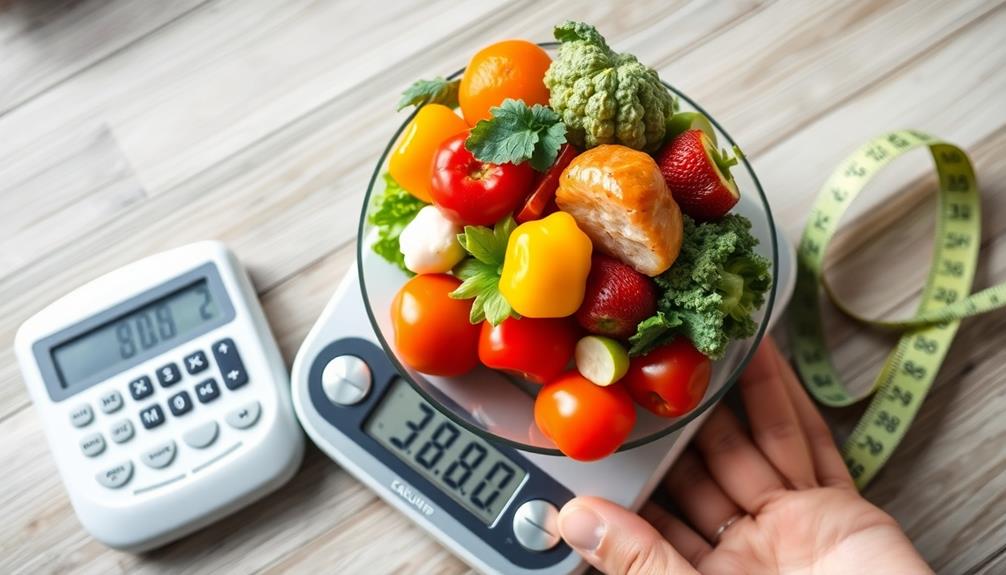To calculate your calorie surplus for bulking, start by determining your maintenance calories. Multiply your weight by 14-16 or track your food intake for a week to find your average daily calories. Next, choose a surplus percentage, typically 10-20% above maintenance. For example, if your maintenance is 2,500 calories, a 15% surplus would be 375 extra calories, bringing your daily target to 2,875. Consider your experience level and body fat percentage when selecting your surplus. Remember to adjust your intake based on progress and focus on nutrient-dense foods. This approach will help you maximize muscle growth while minimizing excess fat gain.
Core Insight
- Calculate maintenance calories by multiplying body weight by 14-16 or tracking food intake for a week.
- Choose a surplus percentage between 10-20% based on experience and body fat levels.
- Add the surplus percentage to maintenance calories to determine daily calorie target for bulking.
- Use online calculators or formulas to find basal metabolic rate and total daily energy expenditure.
- Balance macronutrients with adequate protein (1.6-2.2g/kg body weight) and adjust carbs and fats accordingly.
Understanding Calorie Surplus

A calorie surplus means eating more calories than your body burns. This extra energy helps you build muscle and get stronger in the gym. To bulk up the right way, you need to understand how calorie surpluses work.
First, figure out how many calories you need to maintain your current weight. Then, add an extra 300-500 calories per day. This will give your body the fuel it needs to build muscle steadily without putting on too much fat.
Eating more doesn't mean stuffing yourself with junk food. Choose foods packed with nutrients that support muscle growth and keep you healthy. Keep track of what you eat and make changes if needed to get the best results.
Determining Your Maintenance Calories

Figuring out your maintenance calories is the key to a successful bulk. You need to think about things like your age, gender, height, weight, and how active you are. A simple way to do this is to multiply your weight in pounds by 14-16, depending on your activity level. Just like how cooling towels work because of their special materials, your body burns energy through different processes. So, it's really important to get your calorie numbers right.
For a more accurate number, you can:
- Write down everything you eat for a week
- Keep your weight the same during this time
- Figure out how many calories you eat each day on average
This average is your maintenance calories. Keep in mind, this is just a starting point. You'll have to keep an eye on your progress and change how much you eat if needed. Everyone's metabolism is different, so what works for other people might not work for you.
Choosing Your Surplus Percentage

Deciding on Your Surplus Calories
After figuring out your maintenance calories, the next step is to choose your surplus percentage. This is the extra calories you'll eat to help build muscle. A typical surplus is between 10% and 20% above your maintenance calories. When making your bulking plan, think about your overall health and fitness goals.
If you're new to lifting or have a higher body fat percentage, go with a 10% surplus. This helps you build muscle without gaining too much fat. If you've been lifting for a while and have a lower body fat percentage, you might choose a 15-20% surplus to build as much muscle as possible.
To find your surplus, multiply your maintenance calories by your chosen percentage. For example, if your maintenance is 2,500 calories and you pick a 15% surplus, you'd add 375 calories (2,500 x 0.15). Your new daily calorie target would be 2,875 calories.
Calculating Daily Calorie Needs

Figuring out how many calories you need each day is the key to a successful bulking plan. First, you need to find your basal metabolic rate (BMR), which is the number of calories your body burns while at rest. Then, consider how active you are to determine your total daily energy expenditure (TDEE). This is the total number of calories you burn in a day, including both rest and activity.
You can calculate your TDEE in a few ways:
- Use an online calculator
- Wear a fitness tracking device
- Do the math yourself using formulas like Harris-Benedict or Mifflin-St Jeor
Once you know your TDEE, you have a starting point for figuring out how many extra calories you need to eat to reach your bulking goals.
Macronutrient Balance for Bulking

Macronutrients are key for good bulking. To build muscle and limit fat, you need the right mix of protein, carbs, and fat. Eat 1.6-2.2 grams of protein per kg of body weight for muscle growth. Get 45-65% of calories from carbs for energy and recovery. Choose both complex and simple carbs. Fat should be 20-35% of calories, focusing on healthy fats like avocados and nuts. Grass-fed whey protein is a great choice for its amino acids and health perks. These amounts can change based on your body and training. Space out your macros over several meals each day for steady energy and gains. Track your progress and adjust as needed to reach your goals.
Adjusting Calories Based on Progress

Calculating your calorie surplus is just the starting point. As you keep bulking, you'll need to change your calories based on your results. Check your weight and body composition every week to see how you're doing. If you're having trouble getting enough calories, try adding high-calorie energy bars to boost your daily intake.
If you're not gaining weight like you expected, slowly increase your calories. Add 100-200 calories a day and see what happens over 1-2 weeks. If you're gaining weight too fast or getting too much fat, reduce your calorie surplus a little bit.
Remember these key points when adjusting your calories:
- Keep track of your weight, measurements, and progress photos
- Check your strength gains in the gym
- Be patient and consistent when making changes
Monitoring Body Composition Changes
Tracking your weight is important, but monitoring body composition changes gives you a better idea of your bulking progress. Keep an eye on both muscle gain and fat gain. A few ways to do this:
- Use skinfold calipers to measure body fat percentage.
- Try a scale or handheld device that uses bioelectrical impedance for quick estimates.
- Get a DEXA scan for accurate data, but know that it can be pricey.
- Take progress photos every week in the same lighting and poses.
- Measure your arm, chest, and thigh sizes to track changes.
Check your body composition every 4-6 weeks. If you're gaining too much fat, eat a bit less. If you aren't gaining much muscle, try eating a bit more. Everyone's body is different, so be patient and consistent with tracking your progress.
Avoiding Common Bulking Mistakes

To bulk up successfully, avoid common mistakes that can slow your progress. Many beginners eat too much, gaining more fat than muscle. Instead, eat a moderate amount of extra calories and choose healthy, nutritious foods. Protein snacks like protein cookies can help you get enough protein while satisfying cravings during a bulk.
Another mistake is not lifting weights. Muscles need both good nutrition and exercise to grow. Focus on gradually increasing the weight you lift over time to build muscle effectively.
Finally, remember to:
- Sleep enough for proper recovery
- Drink plenty of water to keep muscles working well
- Stay patient and consistent with your plan
Frequently Asked Questions
How Long Should a Bulking Phase Typically Last?
Your bulking phase typically lasts 3-6 months. It depends on your goals, body type, and training experience. You'll want to monitor progress closely and adjust as needed. Remember, it's not just about gaining weight, but quality muscle mass.
Can I Bulk Without Gaining Fat?
You can't completely avoid fat gain while bulking, but you can minimize it. Focus on a lean bulk by maintaining a small calorie surplus, prioritizing protein intake, and incorporating strength training. It's about balance and patience.
Should I Bulk During a Cut or Maintain Phase?
You shouldn't bulk during a cut or maintain phase. It's counterproductive to your goals. Cutting aims to reduce body fat, while maintaining keeps your weight stable. Bulking requires a calorie surplus, which doesn't align with cutting or maintaining.
Are Cheat Meals Allowed During a Bulking Phase?
Yes, you can incorporate cheat meals during a bulking phase. They're not detrimental if you're still meeting your overall calorie goals. However, don't overdo it, as excessive junk food can hinder your progress and muscle-building efforts.
How Do I Transition From Bulking to Cutting Safely?
To shift safely from bulking to cutting, you'll want to gradually reduce your calorie intake. Start by decreasing your daily calories by 200-300. Maintain your protein intake, adjust your workout routine, and monitor your progress closely. Be patient and consistent.

